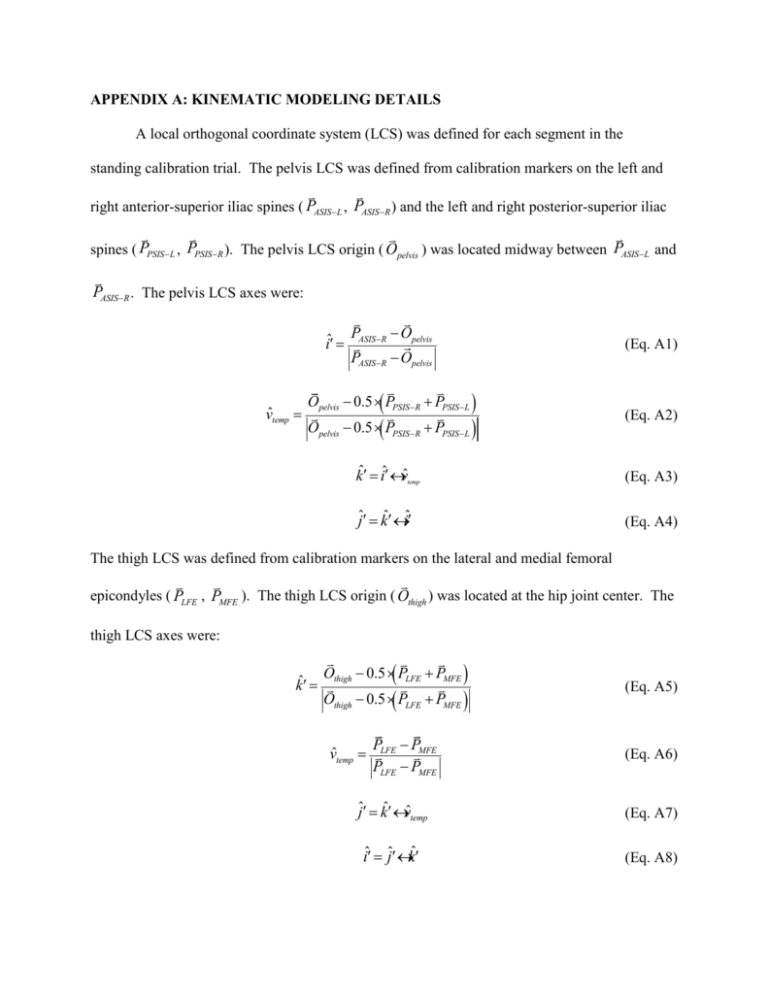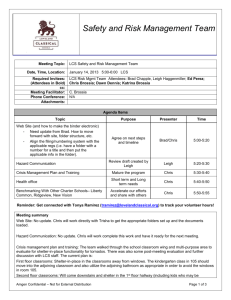APPENDIX A: KINEMATIC MODELING DETAILS A local orthogonal
advertisement

APPENDIX A: KINEMATIC MODELING DETAILS A local orthogonal coordinate system (LCS) was defined for each segment in the standing calibration trial. The pelvis LCS was defined from calibration markers on the left and right anterior-superior iliac spines ( PASIS-L , PASIS-R ) and the left and right posterior-superior iliac spines ( PPSIS-L , PPSIS-R ). The pelvis LCS origin ( Opelvis ) was located midway between PASIS-L and PASIS-R . The pelvis LCS axes were: P - Opelvis iˆ¢ = ASIS-R PASIS-R - Opelvis v̂temp = (Eq. A1) Opelvis - 0.5× ( PPSIS-R + PPSIS-L ) (Eq. A2) kˆ¢ = iˆ¢ ´ v̂temp (Eq. A3) jˆ¢ = kˆ¢ ´ iˆ¢ (Eq. A4) Opelvis - 0.5× ( PPSIS-R + PPSIS-L ) The thigh LCS was defined from calibration markers on the lateral and medial femoral epicondyles ( PLFE , PMFE ). The thigh LCS origin ( Othigh ) was located at the hip joint center. The thigh LCS axes were: Othigh - 0.5× ( PLFE + PMFE ) kˆ¢ = Othigh - 0.5× ( PLFE + PMFE ) v̂temp = PLFE - PMFE PLFE - PMFE (Eq. A5) (Eq. A6) jˆ¢ = kˆ¢ ´ v̂temp (Eq. A7) iˆ¢ = jˆ¢ ´ kˆ¢ (Eq. A8) Two models of the shank LCS were used. The proximal-biased model defined the shank LCS from calibration markers on the lateral and medial femoral epicondyles and the lateral and medial malleoli ( PLMA , PMMA ). The shank LCS origin ( Oshank ) was located midway between PLFE and PMFE . The proximal-biased shank LCS axes were: Oshank - 0.5× ( PLMA + PMMA ) kˆ¢ = Oshank - 0.5× ( PLMA + PMMA ) v̂temp = PLFE - PMFE PLFE - PMFE (Eq. A9) (Eq. A10) jˆ¢ = kˆ¢ ´ v̂temp (Eq. A11) iˆ¢ = jˆ¢ ´ kˆ¢ (Eq. A12) The distal-biased shank model replaces Eq. A10 and defines the frontal plane with vectors between the malleoli: v̂temp = PLMA - PMMA PLMA - PMMA (Eq. A13) The distal-biased shank model was used to calculate ankle angles, and the proximal-biased shank model was used to calculate knee angles. The foot LCS was defined from calibration markers on the lateral and medial malleoli, and the first and fifth metatarsal heads ( PMET1 , PMET 5 ). The foot LCS origin ( O foot ) was located midway between PLMA and kˆ¢ = PMMA . The foot LCS axes were: O foot - 0.5× ( PMET 5 + PMET1 ) O foot - 0.5× ( PMET 5 + PMET1 ) v̂temp = PLMA - PMMA PLMA - PMMA (Eq. A14) (Eq. A15) jˆ¢ = kˆ¢ ´ v̂temp (Eq. A16) iˆ¢ = jˆ¢ ´ kˆ¢ (Eq. A17) For all segments, the 3x3 rotation matrix C was: T C = éëiˆ¢ ĵ¢ k̂¢ùû (Eq. A18) Joint angles (relative LCS orientations) were extracted from a joint orientation matrix R joint computed at each timestep from the walking and running trials: R joint = (CTdistal Rdistal ) (CTproximal R proximal ) T (Eq. A19) where R distal and R proximal are the instantaneous rotation matrices of the distal and proximal segments comprising the joint, calculated using a least-squares minimization routine (Challis, 1995). Equation A19 computes “normalized” joint angles, with the joint poses in the standing calibration trial defining the neutral “zero” angles (Davis et al., 1991). Segment angles were computed in the same fashion, with the identity matrix as R distal . Joint orientations in anatomical terms (e.g flexion/extension) were calculated using a Cardan Xyz rotation sequence, which has been recommended as an international standard in biomechanics and lower limb motion analysis (Wu & Cavanagh, 1995). REFERENCES Challis JH. A procedure for determining rigid body transformation parameters. J Biomech. 1995;28:733-7. Davis RB, Õunpuu S, Tyburski D, and Gage JR. A gait analysis data collection and reduction technique. Hum Mov Sci. 1991;10:575-87. Wu G, Cavanagh PR. ISB recommendations for standardization in the reporting of kinematic data. J Biomech. 1995;28:1257-61.








